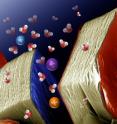Drexel researchers find new energy storage capabilities between layers of 2-D materials
Related images
(click to enlarge)
Drexel University researchers are continuing to expand the capabilities and functionalities of a family of two-dimensional materials they discovered that are as thin as a single atom, but have the potential to store massive amounts of energy. Their latest achievement has pushed the materials storage capacities to new levels while also allowing for their use in flexible devices. About three years ago, Dr. Michel W. Barsoum and Dr. Yury Gogotsi, professors in Drexel's College of Engineering, discovered atomically thin, two-dimensional materials -similar to graphene- that have good electrical conductivity and a surface that is hydrophilic, or can hold liquids. They named these new materials "MXenes," which hearkens to their genesis through the process of etching and exfoliating atomically thin layers of aluminum from layered carbide "MAX phases." The latter also discovered at Drexel about 15 years ago by Barsoum
Since then, the pair, and their team of materials scientists, have forged ahead in exploring the potential uses of MXenes. Their latest findings are reported in the Sept. 27 issue of Science. In their piece entitled "Cation Intercalation and High Volumetric Capacitance of Two-dimensional Titanium Carbide," Gogotsi and Barsoum along with Drexel researchers Maria Lukatskaya, Olha Mashtalir, Chang Ren, Yohan Dall'Angese and Michael Naugib and Patrick Rozier, Pierre Louis Taberna and Dr. Patrice Simon from Université Paul Sabatier in France, explain how MXenes can accommodate various ions and molecules between their layers by a process known as intercalation.
Intercalation is sometimes a necessary step in order to exploit the unique properties of two-dimensional materials. For example, placing lithium ions between the MXene sheets makes them good candidates for use as anodes in lithium-ion batteries. The fact that MXenes can accommodate ions and molecules in this way is significant because it expands their ability to store energy.
"Currently, eight MXenes have been reported by our team, but there are likely many more that will be discovered -- the MXene-and-ion combinations that have been tested to date are by no means an exhaustive demonstration of the material's energy storage capabilities," said Gogotsi, who is also director of the A.J. Drexel Nanotechnology Institute. "So even the impressive capacitances that we are seeing here are probably not the highest possible values to be achieved using MXenes. Intercalation of magnesium and aluminum ions that we observed may also pave the way to development of new kinds of metal ion batteries."
Barsoum and Gogotsi's report looks at intercalation of MXenes with a variety of ions, including lithium, sodium, magnesium, potassium, ammonium and aluminum ions. The resulting materials show high energy storage capacities and present another avenue of research in this branch of materials science.
"Two-dimensional, titanium carbide MXene electrodes show excellent volumetric super capacitance of up to 350 F/cm3 due to intercalation of cations between its layers," Barsoum said. "This capacity is significantly higher than what is currently possible with porous carbon electrodes. In other words, we can now store more energy in smaller volumes, an important consideration as mobile devices get smaller and require more energy"
The researchers also reported on using MXene "paper" electrodes, instead of conventional rolled powder electrodes with a polymer binder. The flexibility of this paper suggests MXenes may also be useful in flexible and wearable energy storage devices, which is another major area of ongoing research at Drexel in collaboration with Professor Genevieve Dion's Shima Seiki Haute Technology Laboratory.
